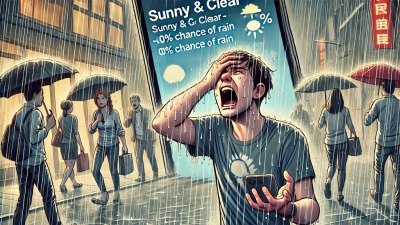Who Actually Believes the Weather Forecast Is Ever 100 Percent Accurate
Exploring the accuracy of weather forecasts and public perceptions.

This image was created with the assistance of DALL·E
The weather forecast has become an integral part of daily life for many people around the world. They check it before planning outdoor activities, deciding what to wear, or even making travel arrangements. Despite the advancements in meteorological technology, some may wonder who actually believes that the weather forecast is ever 100 percent accurate. In reality, the accuracy of these forecasts varies based on numerous factors, including technology, geography, and human interpretation.
The Evolution of Weather Forecasting
Weather forecasting has its roots in ancient civilizations where people observed natural phenomena to predict weather changes. Over the centuries, the methods used in forecasting have evolved from simple observation to complex computer models and satellite technologies. The introduction of these technologies has significantly improved the accuracy of weather predictions, yet still, 100 percent accuracy remains elusive.
The Science Behind Weather Predictions
Weather forecasting is based on the study of atmospheric conditions and the application of scientific principles. Meteorologists utilize various tools such as satellites, radar, and weather balloons to gather data about current weather patterns. Using this data, they employ complex mathematical models to predict future weather conditions. However, the atmosphere is inherently chaotic, meaning that even the most sophisticated models have limitations.
The Role of Technology
In recent years, advancements in technology have played a significant role in improving forecast accuracy. High-resolution models and enhanced satellite imagery allow meteorologists to receive more precise data about weather conditions. Despite these improvements, factors such as localized weather phenomena, atmospheric pressure differences, and rapid changes can lead to inaccuracies. Thus, while technology has advanced, it has not eradicated uncertainties.
Understanding Forecast Accuracy
Forecast accuracy can vary significantly depending on different factors such as the time frame of the forecast. Short-term forecasts, typically within 24 to 48 hours, tend to be more accurate compared to long-term forecasts, which can extend to weeks or months. As forecasts extend further into the future, the reliability tends to diminish, which leads to questions about accuracy among the public.
Public Perception of Weather Forecasts
The Impact of Climate Change
Climate change adds another layer of complexity to weather forecasting. As global temperatures rise, weather patterns become increasingly unpredictable, leading to variations that models can struggle to account for. Extreme weather events, such as hurricanes, heatwaves, and heavy rainfall, can challenge existing forecasting models and contribute to public mistrust when predictions fail to meet expectations.
How Humans Interpret Forecasts
Another aspect to consider is how humans interpret weather forecasts. The language used in forecasts can significantly impact perceptions. For instance, the terms “chance of rain” or “possible snow” can evoke different reactions depending on individual interpretation. Moreover, naivety or misunderstanding about statistical probabilities can skew people’s beliefs about the reliability of forecasts.
The Consequences of Inaccurate Forecasts
Inaccurate forecasts can have serious ramifications, especially in sectors reliant on precise weather conditions. Agriculture, for instance, is highly susceptible to errant forecasts, leading to potential crop losses or suboptimal planting decisions. Similarly, industries like transportation and tourism may find themselves adversely impacted due to unexpected weather changes. This further amplifies public skepticism when forecasts fail to deliver.
Dealing with Uncertainty
Despite the limitations of weather predictions, understanding and coping with uncertainty is essential. Meteorologists often provide forecast ranges, suggesting probabilities rather than definitive outcomes. This probabilistic approach helps to manage expectations and reminds individuals that weather forecasting, while informative, is not infallible. This is crucial in reducing potential disappointment when weather conditions deviate from predictions.
Improving Communication
The way weather forecasts are communicated can significantly affect public trust. Meteorologists need to convey their findings effectively, providing clarity around uncertainties and nuances in predictions. This includes emphasizing the limitations of forecasts, especially with long-term predictions, and fostering a greater understanding of the complexities involved in weather forecasting.
The Role of Citizen Science
Citizen science plays a vital role in improving weather forecasting. By gathering observations from individuals, meteorologists can enhance data accuracy and contribute to better modeling techniques. Engaging the public in weather observation can foster greater trust and appreciation for meteorological efforts. Furthermore, crowdsourced data can help fill gaps in regional forecasts, leading to improved localized predictions.
Engaging the Community
Community engagement is essential to bridge the gap between meteorologists and the public. Workshops, social media outreach, and public forums can provide platforms for discussion and education. Understanding local weather patterns, seasonal changes, and regional variances can cultivate a more informed public, capable of interpreting forecasts with realistic expectations.
Relying on Multiple Sources
In an age of information overload, relying on multiple weather sources can help paint a fuller picture. Various weather services may offer different predictions based on their methodologies, leading to more comprehensive insights. Comparing forecasts can allow individuals to develop a nuanced understanding of anticipated weather patterns. This does not guarantee accuracy but may mitigate reliance on a single forecast.
Conclusion
In conclusion, while many people continue to check weather forecasts daily, the belief in their infallibility remains dubious. The willful skepticism stems from a combination of personal experience, miscommunication, climate change effects, and inherent uncertainties in meteorological science. The key is not to dismiss forecasts altogether but to foster a deeper understanding of their limitations. By promoting better communication, enhancing community engagement, and encouraging the use of multiple sources, a more informed public can develop realistic expectations about weather forecasts. Acknowledging that 100 percent accuracy is an unattainable goal allows for a more responsible consumption of weather information while also recognizing the complexities involved in the science of forecasting.











